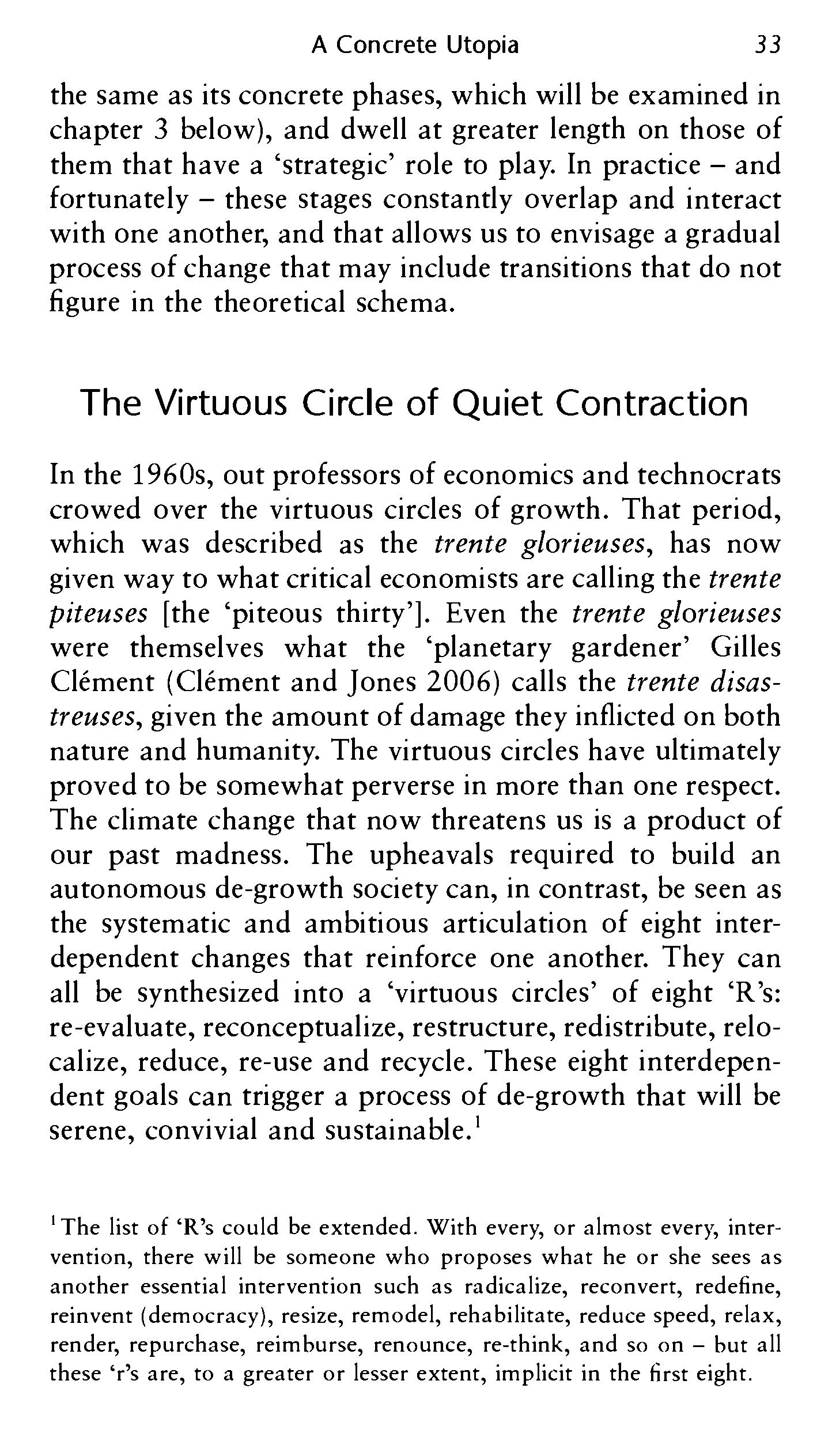
32 minute read
The Virtuous Circle of Quiet Contraction
the same as its concrete phases, which will be examined in chapter 3 below), and dwell at greater length on those of them that have a 'strategic' role to play. In practice - and fortunately - these stages constantly overlap and interact with one another, and that allows us to envisage a gradual process of change that may include transitions that do not figure in the theoretical schema.
The Virtuous Circle of Quiet Contraction
In the 1960s, out professors of economics and technocrats crowed over the virtuous circles of growth. That period, which was described as the trente glorieuses, has now given way to what critical economists are calling the trente piteuses [the 'piteous thirty']. Even the trente glorieuses were themselves what the 'planetary gardener' Gilles Clément (Clément and Jones 2006) calls the trente disas- treuses, given the amount of damage they inflicted on both nature and humanity. The virtuous circles have ultimately proved to be somewhat perverse in more than one respect. The climate change that now threatens us is a product of our past madness. The upheavals required to build an autonomous de-growth society can, in contrast, be seen as the systematic and ambitious articulation of eight inter- dependent changes that reinforce one another. They can all be synthesized into a 'virtuous circles' of eight 'R's: re-evaluate, reconceptualize, restructure, redistribute, relo- calize, reduce, re-use and recycle. These eight interdepen- dent goals can trigger a process of dc-growth that will be serene, convivial and sustainable.'
The list of 'R's could be extended. With every, or almost every, inter- vention, there will be someone who proposes what he or she sees as another essential intervention such as radicalize, reconvert, redefine, reinvent (democracy), resize, remodel, rehabilitate, reduce speed, relax, render, repurchase, reimburse, renounce, re-think, and so on - hut all these 'r's are, to a greater or lesser extent, implicit in the first eight.
34
A Concrete Utopia Re-evaluate. We live in societies that are based upon the old 'bourgeois' values of honoui public service, the trans- mission of knowledge, 'a good job well done', and so on. And yet, 'It is common knowledge that these values have become laughable. . . all that matters is the amount of money you have pocketed, no matter how, and the number of times you have been on television' (Castoriadis 1996: 68). To put it slightly differently, the 'underside' of the system reveals, in Dominique Belpomme's words (2007: 220), 'an individualist megalomania, a rejection of moral- ity, a liking for comfort, and egoism'.2 We can immediately see which values have to be promoted, and which values must take precedence over the dominant values (or absence of values) of the day. Altruism should replace egotism, and unbridled competition should give way to cooperation. The pleasure of leisure and the ethos of play should replace the obsession with work. The importance of social life should take precedence over endless consumerism, the local over the global, autonomy over heteronomy, an appreciation of good craftsmanship over productivist effi- ciency, the rational over the material, and so on. 'A concern for truth, a sense of justice, responsibility, respect for democracy, the celebration of differences, the duty of solidarity and the life of the mind: these are the values we must win back at all cost, as it is those values that will allow us to flourish and to safeguard our future (Belpomme 2007: 221).
The philosopher John Dewey was denouncing 'pecuni- ary culture' and accusing the educational institution of introducing children to the world of competition rather than acting as a laboratory for citizenship a long time ago (Chanial 2006). What would he have made of our com-
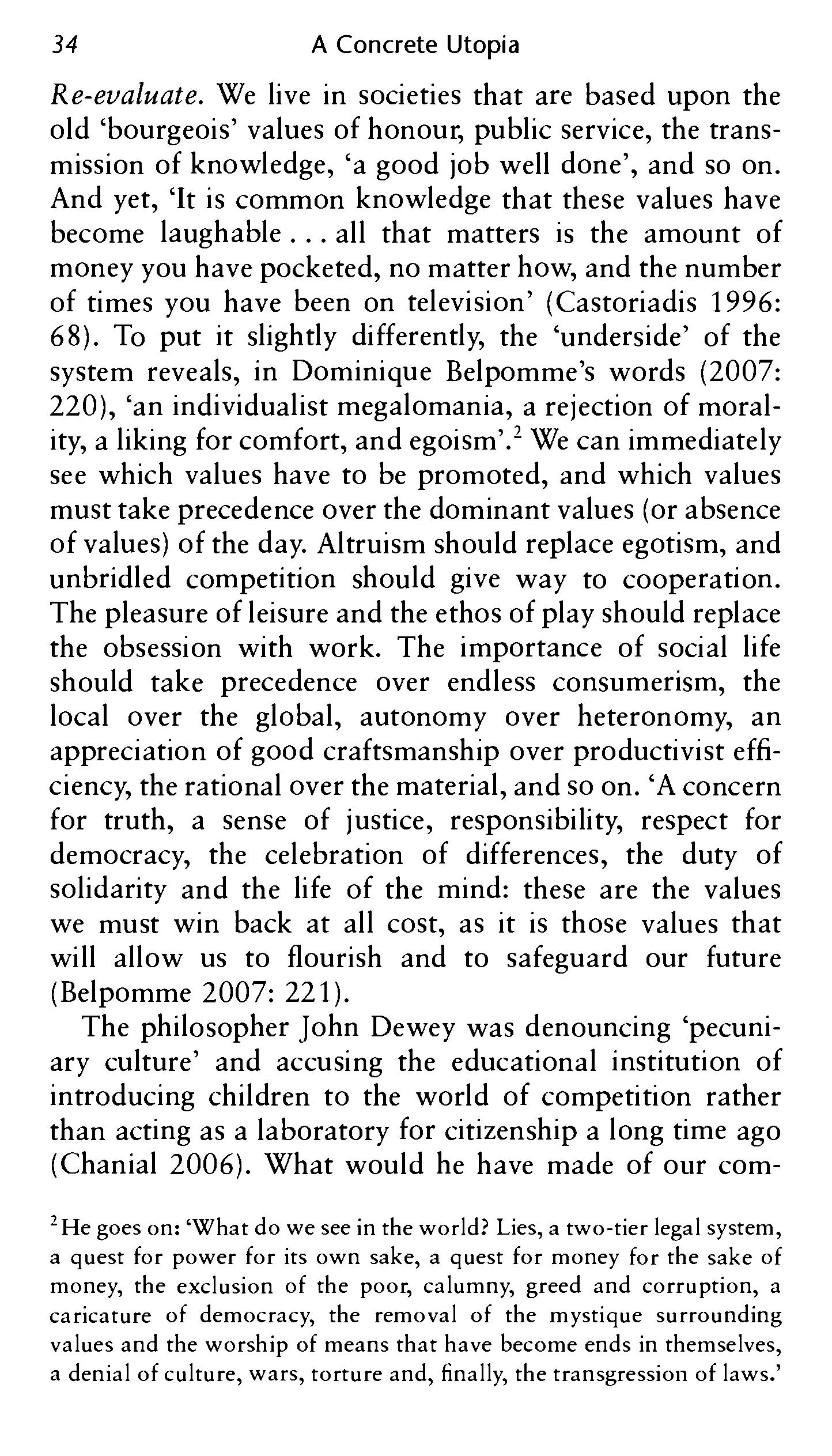
2He goes on: 'What do we see in the world? Lies, a two-tier legal system, a quest for power for its own sake, a quest for money for the sake of money, the exclusion of the poor, calumny, greed and corruption, a caricature of democracy, the removal of the mystique surrounding values and the worship of means that have become ends in themselves, a denial of culture, wars, torture and, finally, the transgression of laws.'
munications society, which uses advertising to manipulate us on a vast scale? 'just as it is difficult to see how a "con- sumer society" could continue to exist if it were made up of citizens whose ascetic morals led them to lead a monas- tic life,' writes François Brune (2006: 173), 'it is hard to imagine a de-growth society functioning with individuals whose every spontaneous and subjective impulse was still shaped by the "consumer society" 's imaginary and "way of life".'
The most important thing is to get away from the belief that we must dominate nature and to try to live in harmony with it. We have to replace the attitude of the predator with that of the gardener. For Christian ecologists, this is in fact the eleventh commandment: 'Respect nature because it is God's creation.'3 The technological and promethean fantasy that we can create an artificial world is a way of rejecting both the world and being.4
Reconceptualize. A change of values allows us to see the world in a new way, and therefore to apprehend reality in a different way. We must, for instance, reconceptualize and redefine/resize the concepts of wealth and poverty; deconstructing the infernal couple of scarcity/abundance, on which the economic imaginary is based, is a matter of urgency. As Ivan Illich and Jean-Pierre Dupuy have clearly demonstrated, the economy transforms natural abundance into scarcity by creating artificial shortages and needs as it appropriates and commodifies nature (Dumouchel and Dupuy 1979; Dupuy and Robert 1976). To take the most recent illustration of this phenomenon: now that water has been privatized, living matter itself is being appropriated.
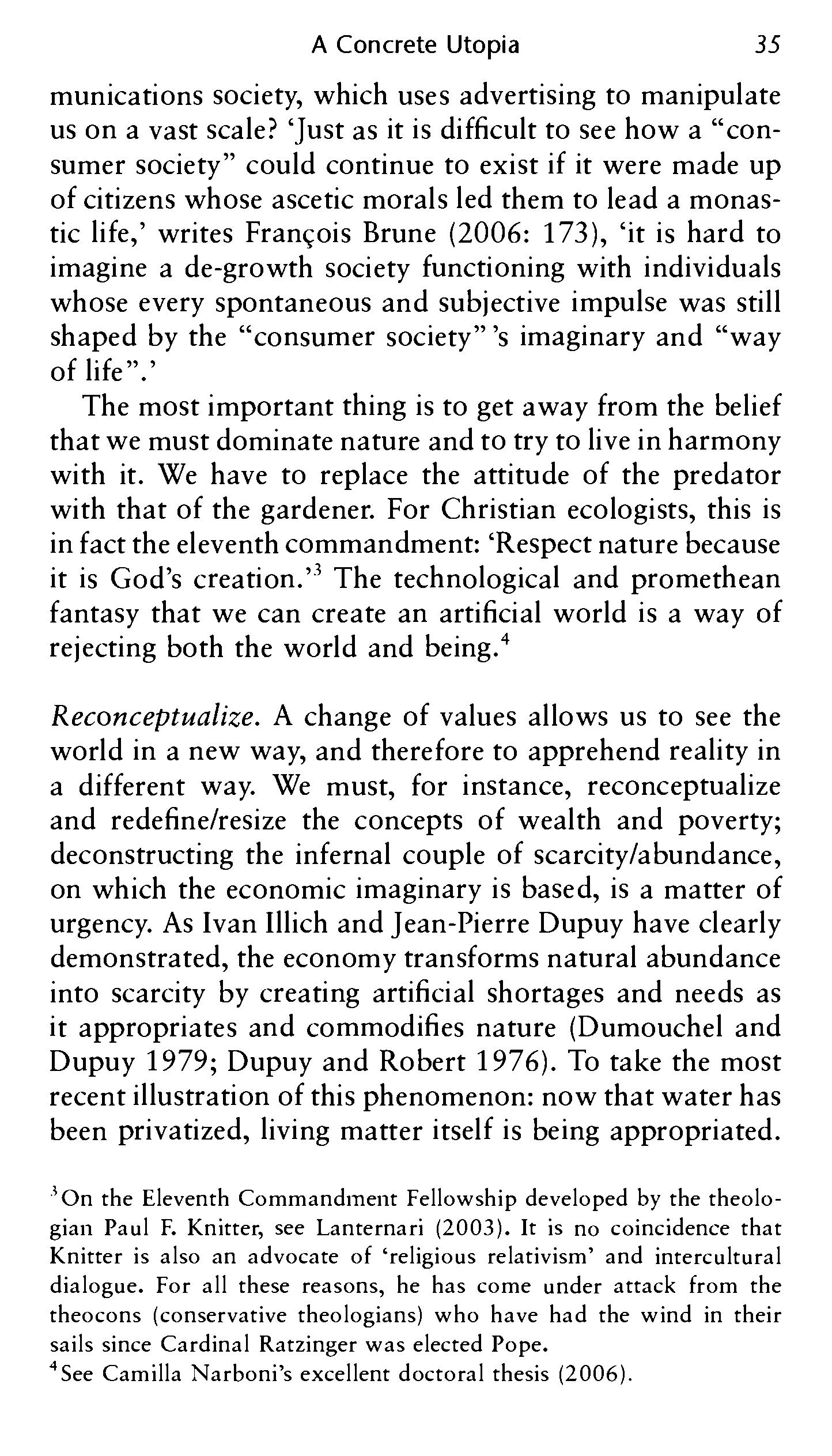
On the Eleventh Commandment Fellowship developed by the theolo- gian Paul F. Knitter, see Lanternari (2003). It is no coincidence that Knitter is also an advocate of 'religious relativism' and intercultural dialogue. For all these reasons, he has come under attack from the theocons (conservative theologians) who have had the wind in their sails since Cardinal Ratzinger was elected Pope. 4See Camilla Narboni's excellent doctoral thesis (2006).
GM crops are the most obvious example. Peasants are being dispossessed of the natural fertility of plants for the benefit of agri-business. 'There are no limits to the mar- ket's imagination,' remarks Bernard Maris (2006: 48). 'It nests in anything that is free, just like a cuckoo. It pushes out the other nestlings, puts its brand on everything that is free, stamps it with its logo, brands it, puts a price on it, and then sells it on.' The economists' assumptions about scarcity become a self-fulfilling prophecy, and we cannot escape the economy without facing up the challenge posed by the depletion of our natural resources.
Restructure. 'Restructuring' means adapting the produc- tive apparatus and social relations to changing values. This restructuring will be all the more radical in that the sys- tematic character of the dominant values will have been destabilized. What is at stake here is finding the road to a de-growth society. This raises the concrete question of getting beyond capitalism, which we will examine at the appropriate moment, and that of reconverting a produc- tive apparatus that has to be adapted to the paradigm shift.5
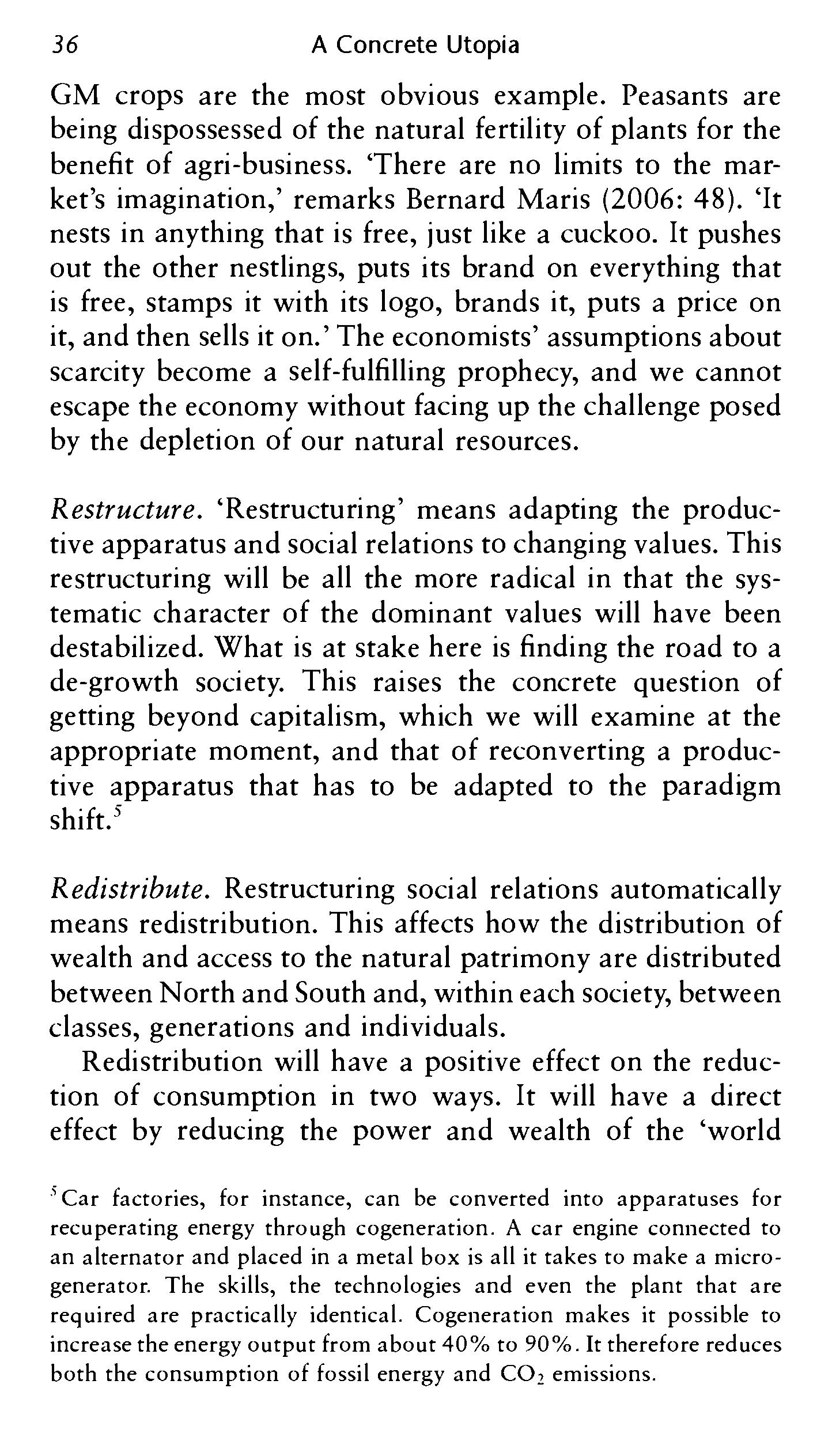
Redistribute. Restructuring social relations automatically means redistribution. This affects how the distribution of wealth and access to the natural patrimony are distributed between North and South and, within each society, between classes, generations and individuals.
Redistribution will have a positive effect on the reduc- tion of consumption in two ways. It will have a direct effect by reducing the power and wealth of the 'world
5Car factories, for instance, can be converted into apparatuses for recuperating energy through cogeneration. A car engine connected to an alternator and placed in a metal box is all it takes to make a micro- generator. The skills, the technologies and even the plant that are required are practically identical. Cogeneration makes it possible to increase the energy output from about 40% to 90%. It therefore reduces both the consumption of fossil energy and CO2 emissions.
consumer class', and especially the power and wealth of the big predators. It will have an indirect effect by remov- ing the incentives to conspicuous consumption. According to Thorstein Veblen's classic analysis (1970 [18991),6 the desire to consume has less to do with need than with the desire to assert our status by imitating the model of those who are just above us.
Redistributing North/South relations raises huge prob- lems. We have contracted a huge 'ecological debt' (Attac 2006) to the South. Beginning to reduce it whilst at the same time reducing our own predation is simply a matter of fairness. As we shall see, it is not so much a matter of
giving more as of taking less.7
Ecological footprints (which can even be broken down by types of activity and consumption) are a good way of determining each country's 'drawing rights'. 'Markets' in those rights would encourage the exchange of quotas and permits to consume. This is obviously not a way of corn- modifying nature a little more, but a way of introducing a certain suppleness into how its limitations are managed. Here, as elsewhere, the challenge is found in suiting actions to words.
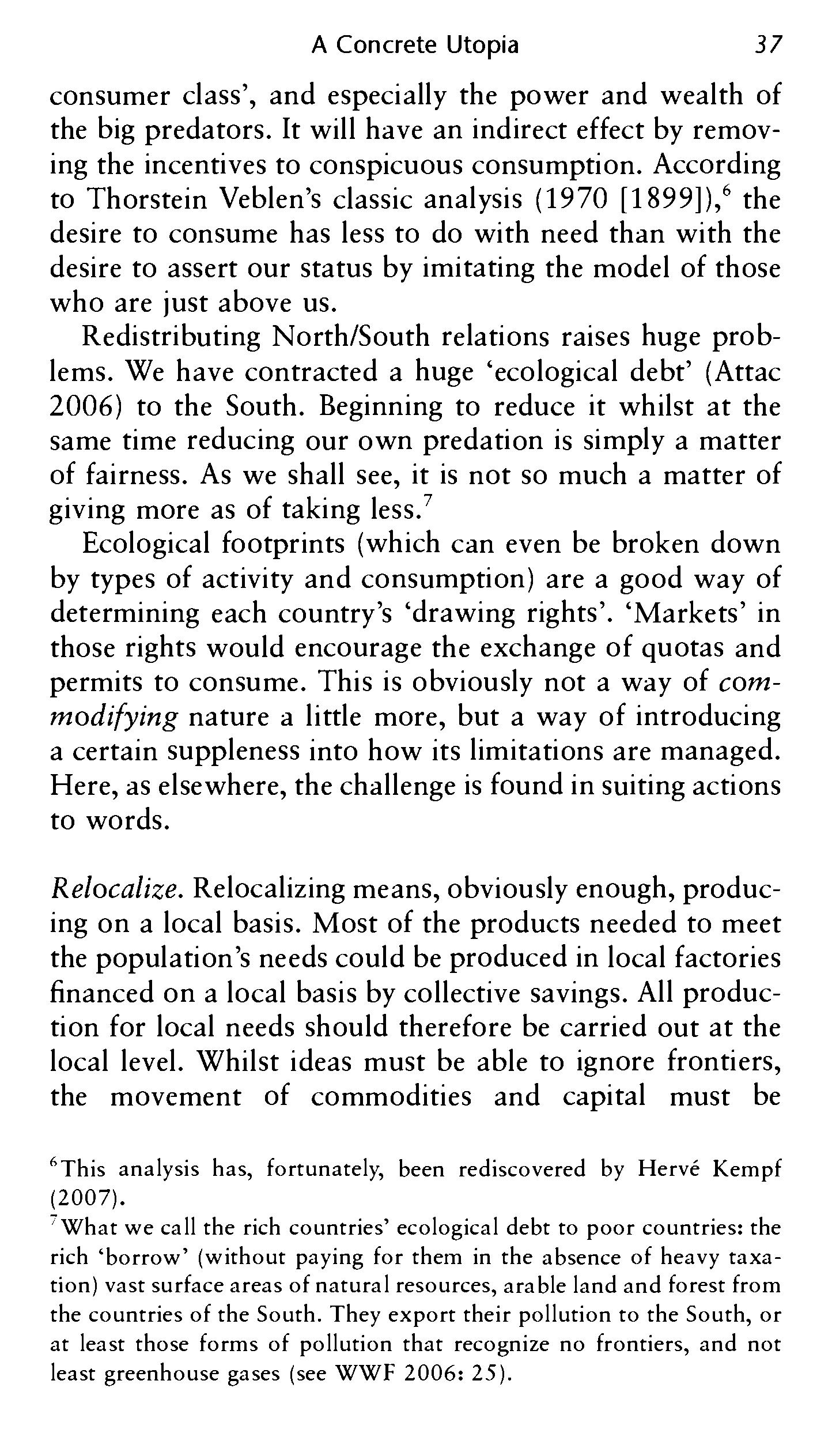
Relocalize. Relocalizing means, obviously enough, produc- ing on a local basis. Most of the products needed to meet the population's needs could be produced in local factories financed on a local basis by collective savings. All produc- tion for local needs should therefore be carried out at the local level. Whilst ideas must be able to ignore frontiers, the movement of commodities and capital must be
6This analysis has, fortunately, been rediscovered by Hervé Kempf (2007). 7What we call the rich countries' ecological debt to poor countries: the rich 'borrow' (without paying for them in the absence of heavy taxa- tion) vast surface areas of natural resources, arable land and forest from the countries of the South. They export their pollution to the South, or at least those forms of pollution that recognize no frontiers, and not least greenhouse gases (see WWF 2006: 25).
38 A Concrete Utopia restricted to essentials. If we wish to build a serene de- growth society, relocalization is not just an economic issue: politics, culture and the meaning of life must redis- cover their local roots. This implies that all economic, political and cultural decisions that can be made at the local level must be made at that level.
Reduce. 'Reducing' means, first of all, reducing the impact of our ways of consuming and producing on the bio- sphere. We must begin by reducing our habitual over- consumption and the incredible amount we waste: 80% of goods on the market are used only once, and then go straight into the dustbin (Hulot 2006: 237)! The rich countries now produce four billion tonnes of waste every year (Maris 2006: 327). Production of domestic waste per household is 760 kg a year in the United States, 380 kg in France and 200 kg in most countries of the South (Paquot 2007a: 45). Both health risks and working hours should also be reduced. Reducing health risks implies 'precauvention' (prevention/precaution), to use Professor Belpomme's neologism, rather than reparations - it is worth remembering that, in 2005, French pharmacies sold 2.6 billion boxes and phials, an increase of 8% on the previous year.
The other thing that has to be reduced is mass tourism. The golden age of kilometric consumerism is over. At the moment when Richard Branson, the British billionaire owner of Virgin, wants to put space tourism within every- one's reach (Le Monde, 19 April 2006), even the very orthodox Financial Times admits that 'tourism will be identified as the world's number one environmental enemy' (Tomkins 2006).
The desire to travel and a taste for adventure are no doubt part of human nature. They are a source of enrich- ment that must not be allowed to dry up, but the tourist industry has transformed legitimate curiosity and educa- tional inquisitiveness into a consumerist consumption that destroys the environment, culture and social fabric of the
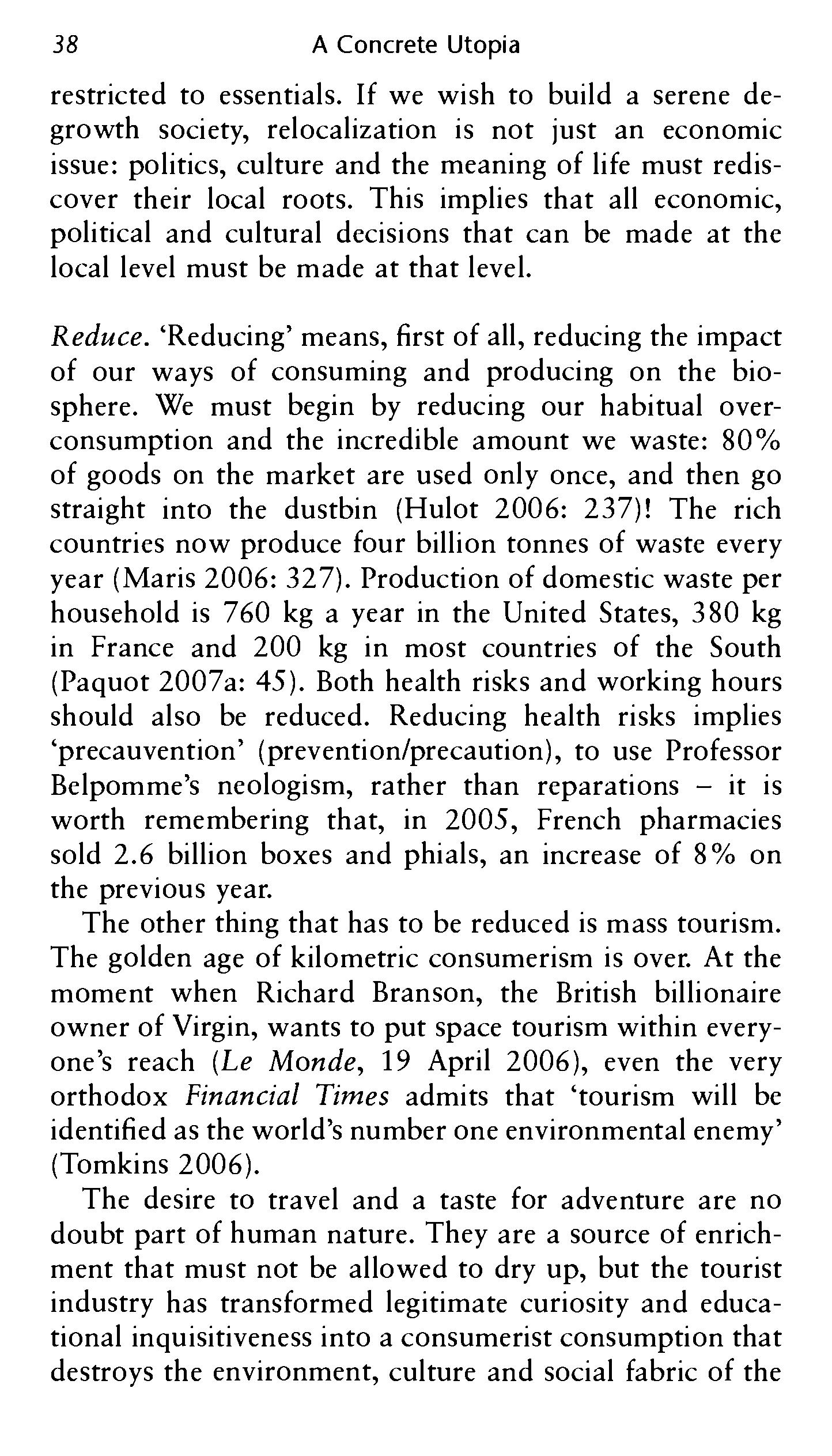
'target' countries. 'Travelitis', or our obsession with trave!- ling further and further, faster and faster, and more and more often (and always for less) is a largely artificial need that has been created by 'supermodern' life, exacerbated by the media and stimulated by travel agencies and tour operators, and it must be revised downwards. Whether or not 'eco-tourism', which is defined as an ethical, fair and responsible tourism and as an alternative to mass tourism, is an oxymoron that colludes with sustainable develop- ment is a legitimate question. Is it not designed to prolong the survival of a commodified, condemned and condem- nable activity? The excuse that it is helping the South to develop is fallacious. According to Artisans du monde, of the 1,000 euros spent on a holiday package, less than 200 euros remains in the host country. The coming oil shortage and climate change promise us a very different future: not so far, less often, slower and ever more expensive. Truth to tell, this is becoming tragic only because of the empti- ness and disenchantment that mean that, whilst we live to an increasing extent in virtual reality, we travel in real time, and at the planet's expense. We have to relearn the wisdom of past ages: enjoy slowness and appreciate our own territory.
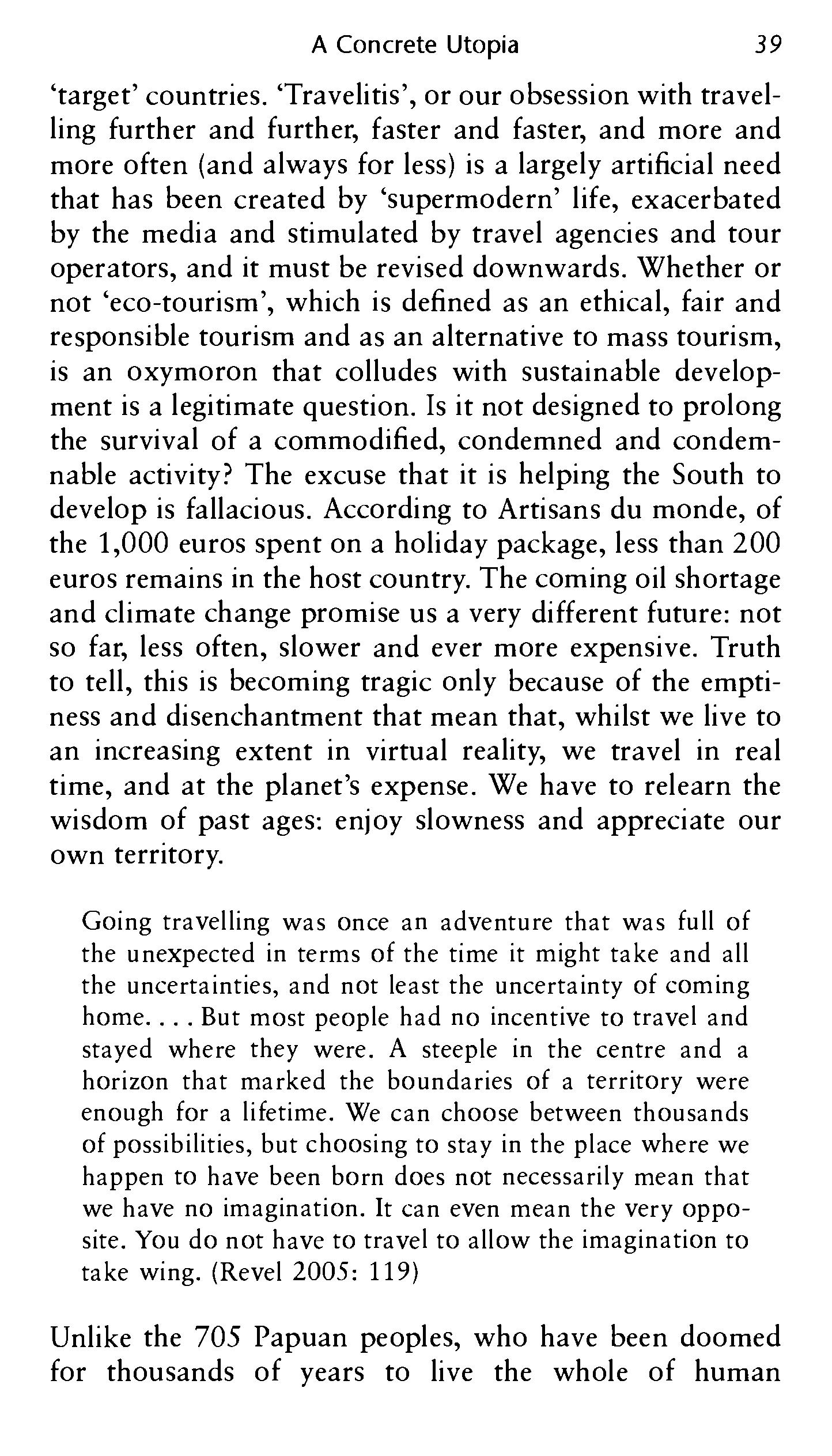
Going travelling was once an adventure that was full of the unexpected in terms of the time it might take and all the uncertainties, and not least the uncertainty of coming home.. . . But most people had no incentive to travel and stayed where they were. A steeple in the centre and a horizon that marked the boundaries of a territory were enough for a lifetime. We can choose between thousands of possibilities, but choosing to stay in the place where we happen to have been born does not necessarily mean that we have no imagination. It can even mean the very oppo- site. You do not have to travel to allow the imagination to take wing. (Revel 2005: 119)
Unlike the 705 Papuan peoples, who have been doomed for thousands of years to live the whole of human
40
A Concrete Utopia experience within the limited horizons of their canton, we, thanks to the wonders of technology, have the unprece- dented good fortune to be able to travel in virtual reality without leaving home. And after all, adventurous souls can always windsurf to the Seychelles. . . if the islands have not been swallowed up by the sea.
Shortening the working week is, finally, an essential element, as we shall see when we discuss policies for fight- ing unemployment. This obviously means job-sharing to ensure that anyone who wants a job can find one. A shorter working week must go hand in hand with the pos- sibility of changing one's job as the economic Situation changes or at different times in one's personal life. Accord- ing to Willem Hoogendijk (2003), types of activity should be diversified: 'If demand for shoes or TVs drops off.. . then production at the respective plants will simply be cut back for a while, freeing up the staff and workers for other activities.'8 Wage-earners could work in agriculture or commercial garden centres or on building sites. They could work in the transport sector, in education or on Sports schemes for disturbed adolescents. As is obvious from what they do with their spare time, most people have talents that extend far beyond the jobs they usually do for a living. Although the unions are, for the moment and for understandable reasons, hostile to them, temp agencies, which are popular with both employers and workers - because of the variety of jobs they offer - represent a step in the right direction. We just have to see them in a differ- ent light.
Above all, we must be weaned off our addiction to 'the job', as it is a major element in the tragedy of productiv- ism. We will not be able to build a serene de-growth society unless we rediscover the repressed dimensions of life: the leisure to do one's duty as a citizen, the pleasure of the freedom to engage in freely chosen arts and crafts
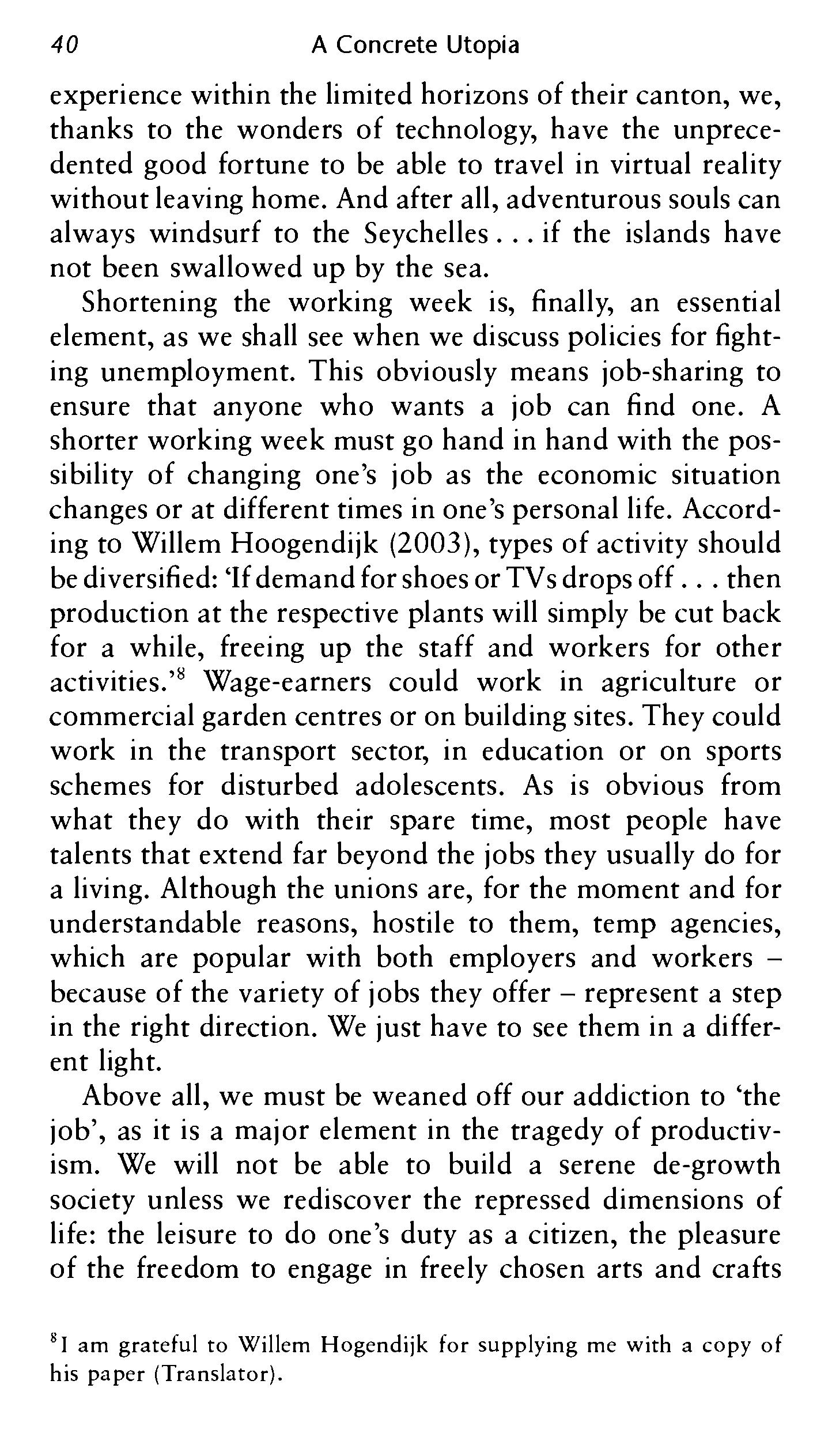
am grateful to Willem Hogendijk for supplying me with a copy of his paper (Translator).
activities, the sensation of having found time to play, con- template, meditate, enjoy conversations or quite simply to enjoy being alive.9
Re-use/recycle. No one in their right mind would deny that we have to reduce conspicuous waste, fight the built-in obsolescence of appliances, and recycle waste that cannot be re-used directly. The possibilities are endless, and many have been tested on a small scale. The Swiss firms Rohner and Design Tex have, for example, developed and pro- duced an upholstery fabric that is naturally degradable once it has reached the end of its life cycle. Other compa- nies have developed carpets made of organic materials that can be used as mulch for parks when they are worn out. The German chemicals giant BASF has developed a fabric made from nylon fibre that can be recycled indefinitely and that breaks down - when the product to which it gave birth then had worn out be re-used in - into its basic new products. elements, which In 1990, Xerox can - a company specializing in photocopiers - developed a pro- gramme that allows products to be seen as an assemblage of parts that can be recycled when they have reached the end of their useful life. When its copiers are returned to it, Xerox undertakes to re-use most of the raw materials from which they are made (Bevilacqua 2006: 129). Once again, what is missing is the incentive that will put both manu- facturers and consumers on the 'virtuous' path. And yet it is easy to come up with such incentives; we simply lack the political will to implement them.
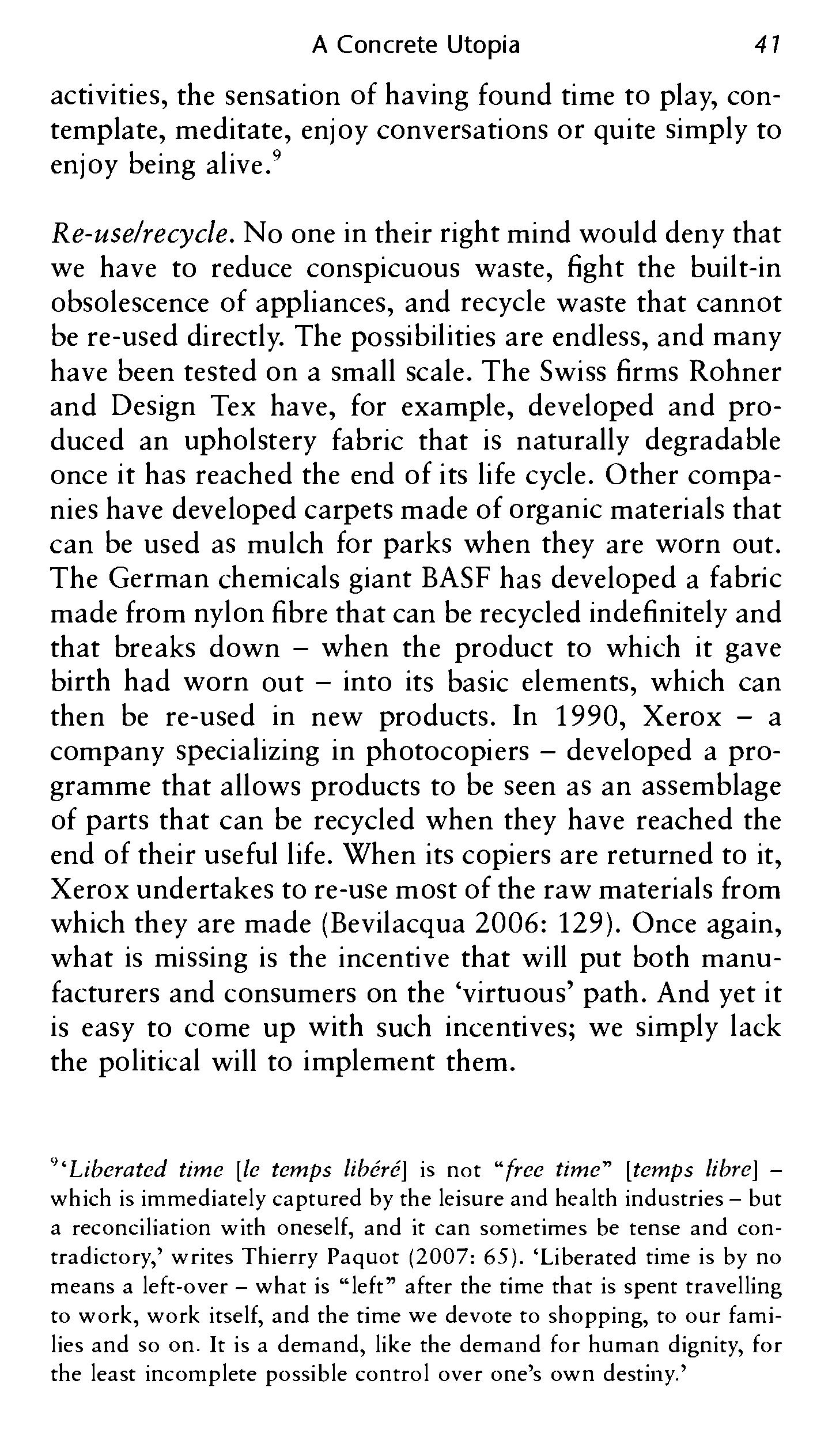
9'Liberated time [le temps libéré] is not "free time" [temps libre] - which is immediately captured by the leisure and health industries - but a reconciliation with oneself, and it can sometimes be tense and con- tradictory,' writes Thierry Paquot (2007: 65). 'Liberated time is by no means a left-over - what is "left" after the time that is spent travelling to work, work itself, and the time we devote to shopping, to our fami- lies and so on. It is a demand, like the demand for human dignity, for the least incomplete possible control over one's own destiny.'
42 A Concrete Utopia
All this points the way towards a utopia in the best sense of the term. This utopia is an intellectual construct that functions on an ideal basis, but it is also concrete in the sense that it takes as its starting point elements that already exist and changes that can be implemented. If we want it, we can have another world that is at once desirable, neces- sary and possible.
Within this project, autonomy has to be understood in the strong and etymological sense of the term (autonomos: 'He who establishes his own norms') and as a reaction against the heteronomy of the 'invisible hand' of the market, the dictatorship of financial markets and the diktats technoscience issue to (super-)modern society. This autonomy does not imply boundless freedom. As Aristotle reminds us, we have to learn to obey before we can learn how to command. In a society of free citizens, 'learning' to obey has to be understood as meaning serving an apprenticeship, as a non-servile obedience to the law we have chosen to obey (servile obedience is an apprenticeship in tyranny). There is no denying that voluntary servitude can be enjoyable in both cases. When it comes to 'con- sumption', the dividing line between an instrumental usage that respects individuals and an instrumentalization that does not is both tenuous and problematic. The existence of efficient forms of reciprocity marks all the difference between the two forms. This is one of the many challenges that a democratic society always has to face. Hence the importance of conviviality.
Conviviality, which Ivan Illich (1972) borrows from the great eighteenth-century French gourmet Brillat-Savarin,'° is designed to reknit the social bond that has been unrav- elled by what Arthur Rimbaud called the 'horrors of eco- nomics'. Conviviality reintroduces the spirit of the gift into trade, alongside the law of the jungle, and thus restores the link with Aristotle's philia ('friendship').
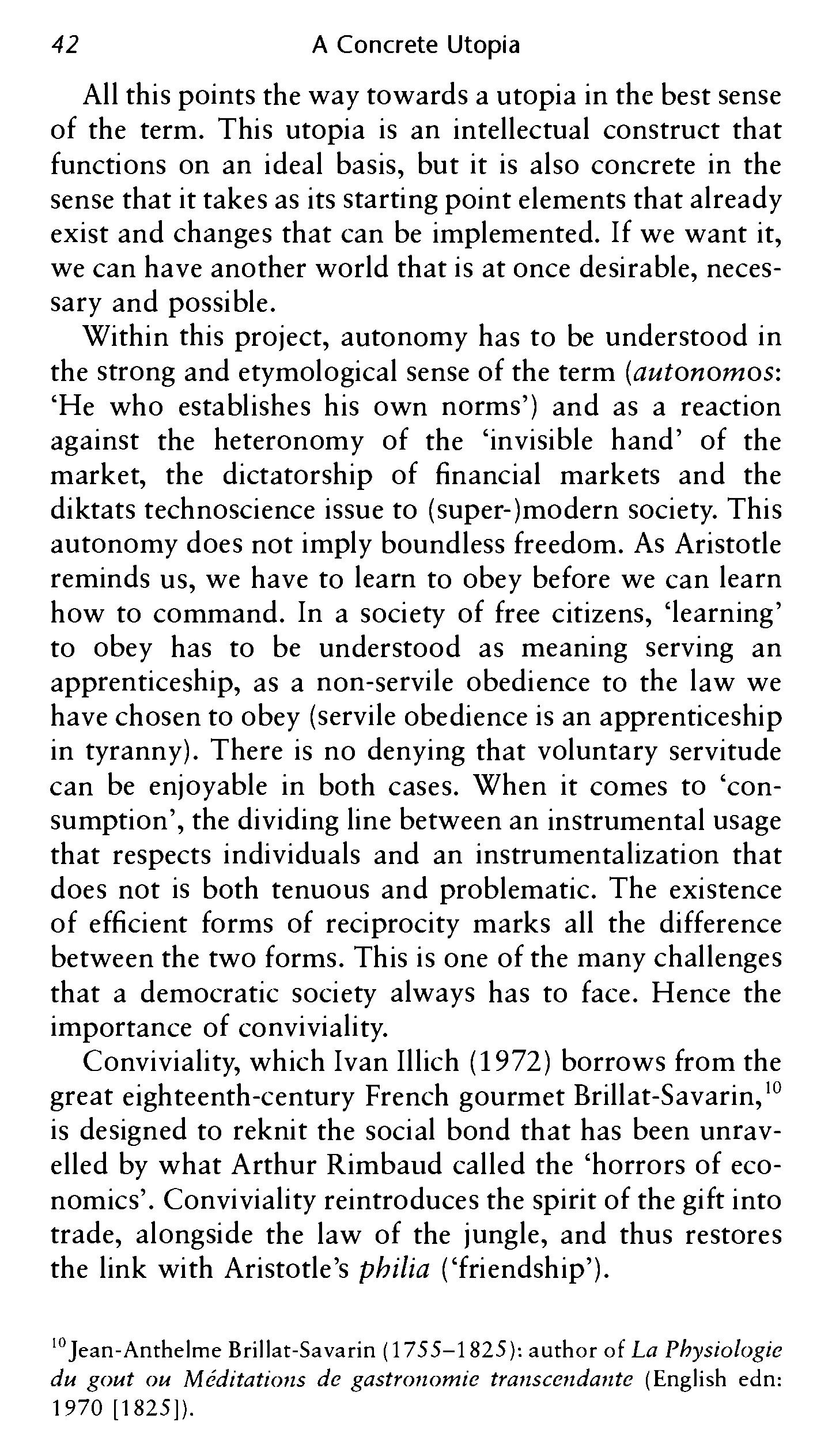
'°Jean-Anthelme Brillat-Savarin (1755-1825): author of La Physiologic du gout ou Méditations de gastronomie transcendante (English edn: 1970 [1825)).
Some will no doubt see the systematic recourse to the prefix 're' in the eight 'R's as the hallmark of a reactionary way of thinking, or as a romantic or nostalgic desire to go back to living in the past. Let me simply say that, leaving aside a certain flirtatiousness on the author's part (placing its stages under the sign of the letter 'R'), the actions in question are as much part of a revolution as a backward move, and are at once innovative and repetitive. If there is an element of reaction, it is a reaction to the system's excesses and hubris - which finds expression in the many 'overs' that Jean-Paul Besset denounces, and which should be replaced by 're's, over-development, over-production, over-abundance, over-extraction, over-fishing, over-grazing, over-consumption, over-packaging, over-communications, too much traffic [surcirculationl, over-medicalization, over-indebtedness, over-supply. . . (Besset 2005: 182).'' As Michael Singleton remarks (2006: 53), this over- speeding thermo-industrial system is doing more and more damage, which we can sum up in 'a growing list of words beginning with the prefix "de": industrial delocalization, monetary deflation, political disenchantment [désenchante- menti, cultural demotivation and religious demystification. Whatever else we do,' he adds, 'we have to ensure that the "de" in de-growth echoes the "putting off the inevitable" to which the original Latin dis lends itself so well.' At the centre of the virtuous circles of the eight 'R's cultural revo- lution, there is another 'R' that is implicit in all of them: resist.
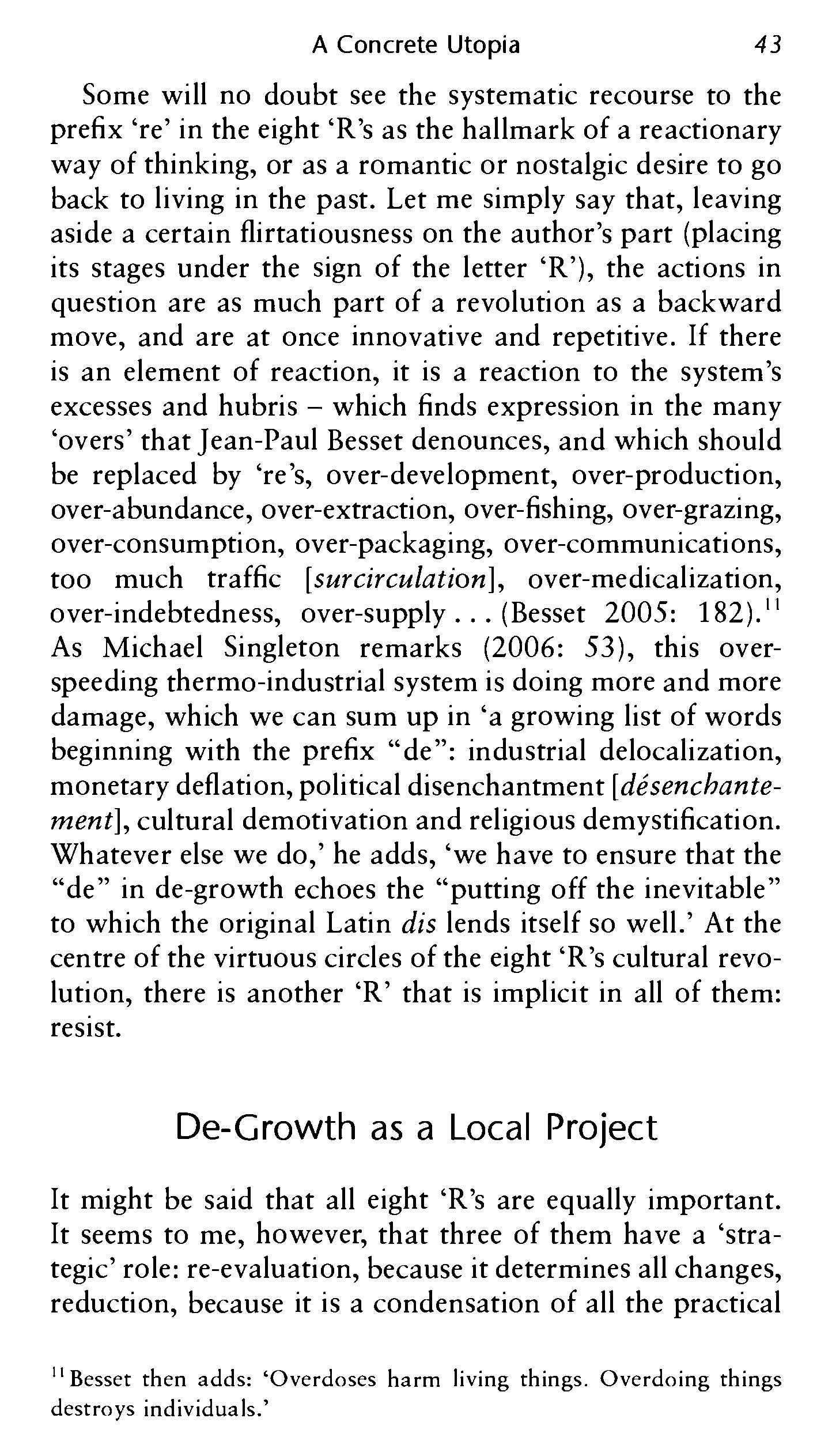
De-Growth as a Local Project
It might be said that all eight 'R's are equally important. It seems to me, however, that three of them have a 'stra- tegic' role: re-evaluation, because it determines all changes, reduction, because it is a condensation of all the practical
44
A Concrete Utopia imperatives of de-growth, and relocalization, because it concerns the everyday lives and jobs of millions of people.'2 Relocalization therefore has a central role to play in our concrete utopia, and almost immediately suggests a politi- cal programme. De-growth appears to give a new life to the ecologists' old slogan of 'Think globally, act locally'. Whilst the utopia of de-growth implies thinking at a global level, its realization begins at grassroots level. There are two interdependent sides to the local de-growth project: political innovation and economic autonomy.
Inventing Local Ecological Democracy
One solution to the urban and political peripheralization generated by the growth society might be a return to Murray Bookchin's 'utopia' of 'ecomunicipalism' (Book- chin 1980). Bookchin envisaged here an ecological society made up of a municipality of municipalities, each in turn made up of a commune of small communes, in perfect harmony with their ecosystems (Magnaghi 2006: 100). The reconquest or reinvention of 'commons' (common goods, common spaces) and self-organized 'bioregions' might be one illustration of this approach (Esteva 2004; Esteva and Prakash 1998). A bioregion or ecoregion, defined as a coherent spatial entity that expresses a geo- graphical, social and historical reality, might be predomi- nantly rural or predominantly urban. An urban bioregion could be described as a municipality of municipalities, a 'town of towns' or even a 'town of villages', or in other words an ecopolis, meaning a polycentric or multipolar network (Magnaghi 2006: 69-1 12). A bioregion consists of a complex set of local territorial systems with a high capacity for an ecological self-sustainability designed to
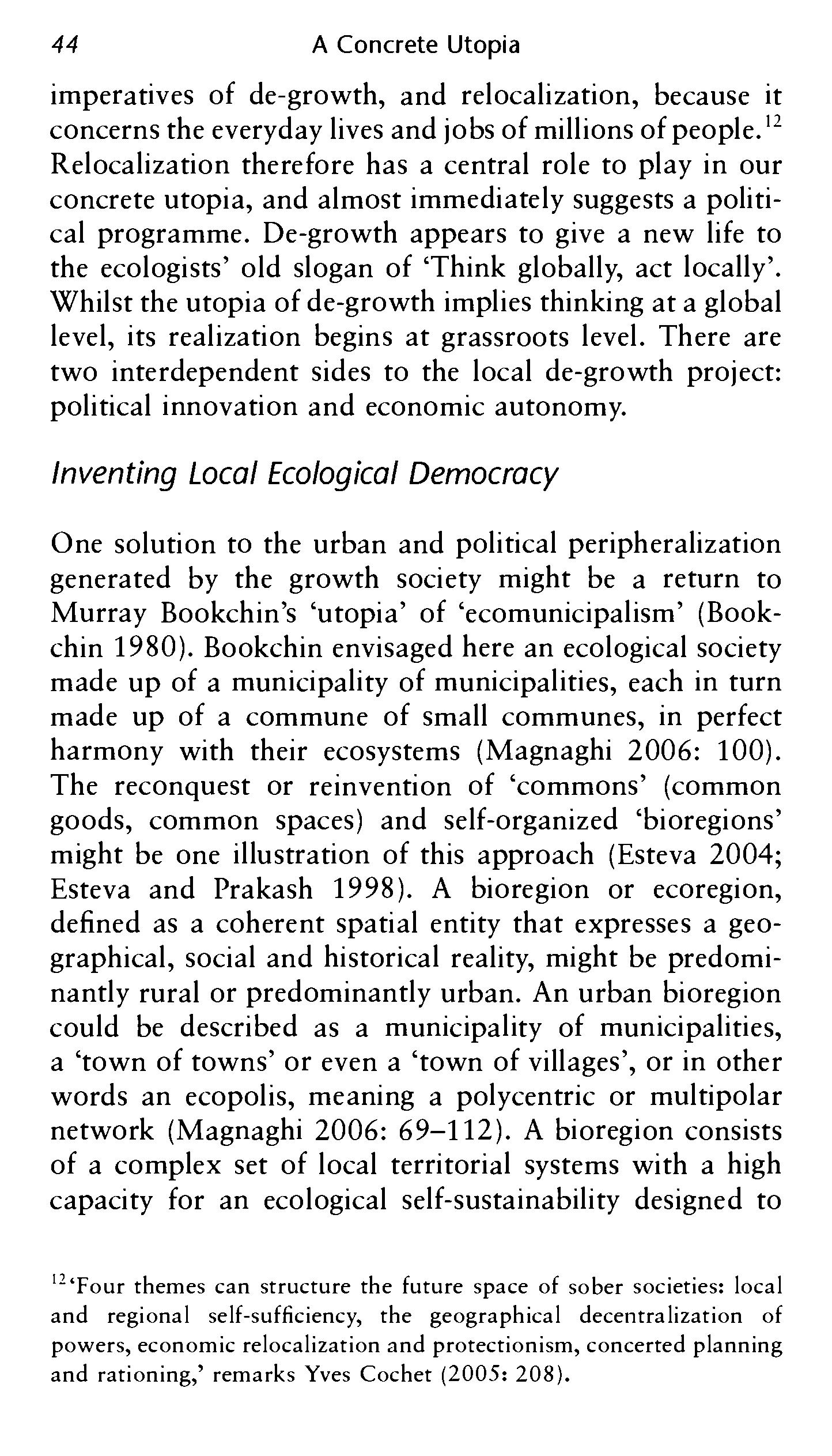
'2'Four themes can structure the future space of sober societies: local and regional self-sufficiency, the geographical decentralization of powers, economic relocalization and protectionism, concerted planning and rationing,' remarks Yves Cochet (2005: 208).
reduce externa! diseconomies and energy consumption (Bonora 2006).
According to some, this puts us in a 'democratic dilemma' that might be summed up thus: the smaller the politica! entity/unit and the more direct contro! its citizens have, the more restricted its domains of sovereignty (Dahl 1983). Its capacity for decision-making and action cannot apply to questions that extend beyond its territorial limits, and wi!l be influenced by externa! dynamics (Bonora 2006: 113), especial!y in the ecological domain. As its territorial political constituency expands, on the other hand, its citizens will have fewer opportunities to participate in decision-making. That is a truism, but Paola Bonora sug- gests that we shou!d approach the question in terms of identity rather than size. What matters is the existence of a collective project rooted in a territory, defined as a place for communal living that must be protected and cared for the good of a!!. Participation, which is then imp!icit in action, becomes the 'guardian and promoter of the spirit of the place' (Bonora 2006: 114). Size is no longer a topo- graphica! problem, but a socia! prob!em. We are talking about a space with a recognizable identity and a capacity for coordinated collective action. Bookchin's idea that a metropolitan area could be an articulated set of autono- mous neighbourhoods that function as juxtaposed com- munes is interesting, but it can work on!y if the neighbourhood councils have real power and are not just transmission belts.
The 'new communes' network in Italy is certainly one of the most origina! and most promising initiatives.'3 This is an association made up of researchers, social movements and many local politicians from small communes, but also from !arger entities such as the province of Milan and the Tuscany region which are trying to so!ve the prob!ems generated by the excesses of the growth society at the local
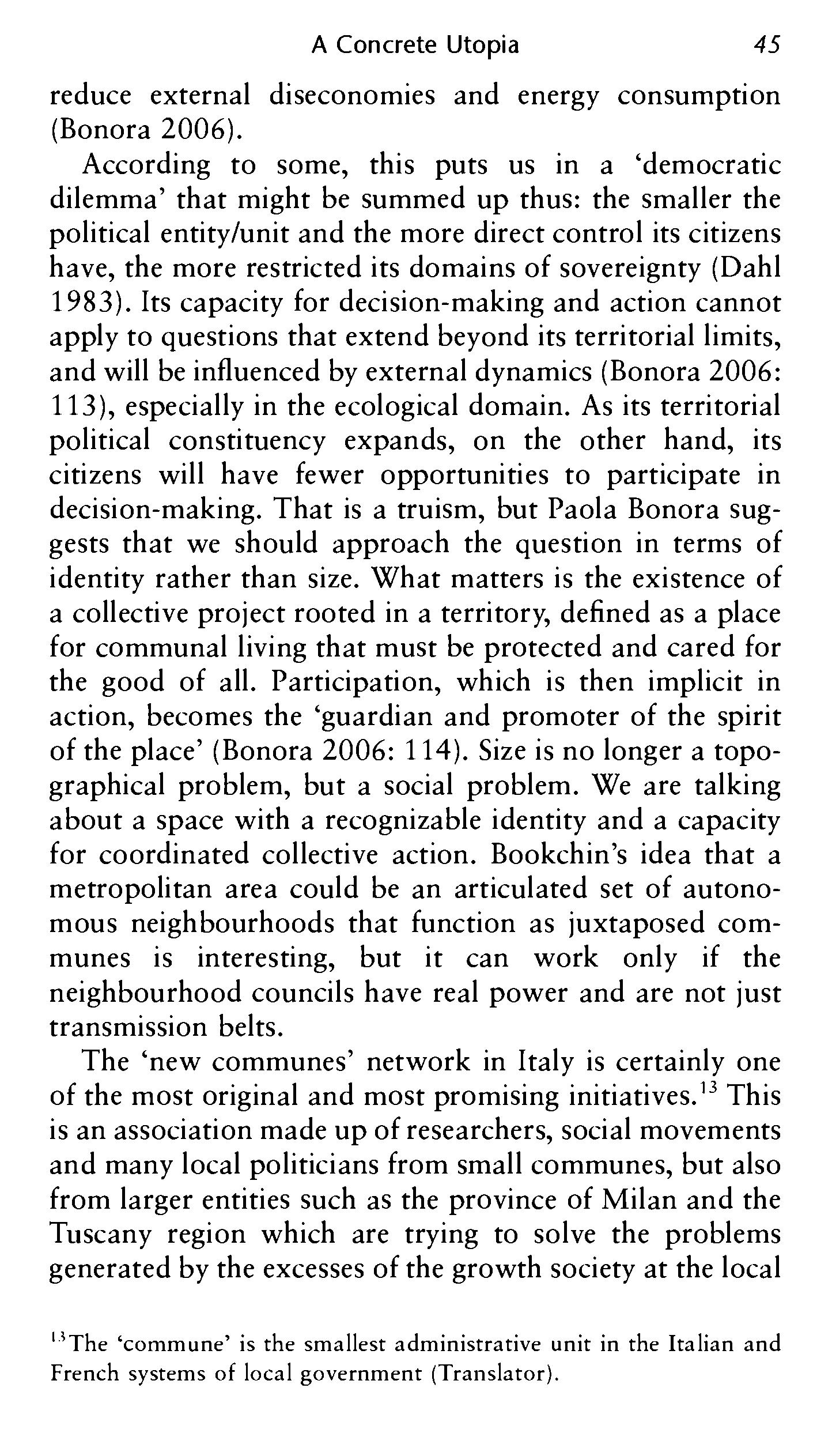
'The 'commune' is the smallest administrative unit in the Italian and French systems of local government (Translator).
A Concrete Utopia level and in honest ways. The most original feature of the network, whose meeting in Bari in October 2005 was attended by five hundred participants, lies in its choice of a strategy based upon a territory. The 'local', in other words, is seen as a field where social actors, a physical environment and territorial patrimonies can interact. According to the network's charter, this is 'a political project that values local resources and specificities, encour- ages processes of conscious and responsible autonomy, and refuses to be steered from outside by the invisible hand of the global market (hetero-leadership)'.'4 It is, in other words, a laboratory for a critical analysis, and for self- government and the defence of common goods. The exper- iment has a lot in common with the 'urban village' idea and with the example set by the 'slow city' movements.'5 This movement complements the slow food movement, which has been joined by 100,000 producers, peasants, artisans and fishermen all over the world in order to fight the standardization of food and to rediscover taste and local specialities (Petrini 2006). Although it has put down deep roots, this local project is neither closed nor egotisti- cal; 'on the contrary, it presupposes openness and a gener- ous idea of giving and taking' (Bonora 2006: 118).
The de-growth society implies a high level of protection- ism against unbridled and unfair competition, but it also implies a great openness towards 'spaces' that adopt com- parable measures. If, as Michel Torga was already saying in 1954, 'the universal is the local without walls', we can deduce that the local, conversely, is the universal plus frontiers, boundaries, buffer zones, smugglers, interpreters and translators. An identity that has been chosen, that is
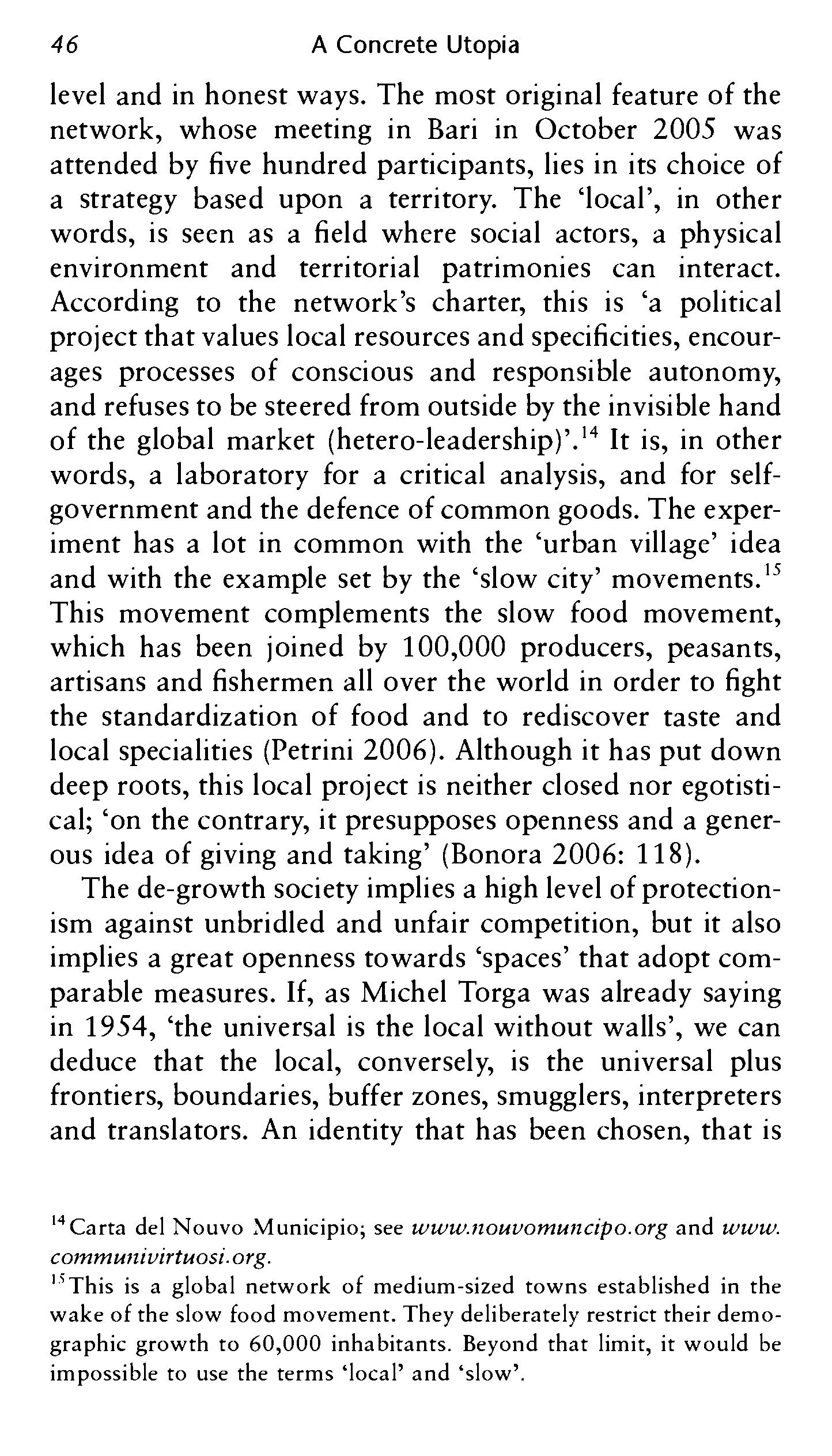
'4Carta dei Nouvo Municipio; see www.nouvomuncipo.org and www. communivirtuosi. org. 'This is a global network of medium-sized towns established in the wake of the slow food movement. They deliberately restrict their demo- graphic growth to 60,000 inhabitants. Beyond that limit, it would be impossible to use the terms 'local' and 'slow'.
to a greater or lesser extent plural and that is still bound up with a shared vision of its destiny, is an essential element in guaranteeing a bioregional unit its consistency.16
Michael Singleton notes that there is a great danger that anyone who uses the words 'local' and 'community', and who casts doubt on the possibility or opportuneness of an abstract political universalism (which is code for world government),
will be called all the names that Modernity has anathe- mized: fascism, nationalism, male chauvinism, paternal- ism, elitism, nostalgia for the past. . . . How can we get people to understand that de-growth is not a return to the fetters of comunitarianism (the small nuclear family, the posh area, regional egotism . . .), but to an organic 're- weaving' of the local (allowing people to spend more time together, as they did until the 1960s, thanks to, amongst other things, village schools, 'family' firms, local shops and local cinemas rather than spending their days shuttling between schools, industrial zones and out-of-town super- markets)? (Singleton 2006: 52)
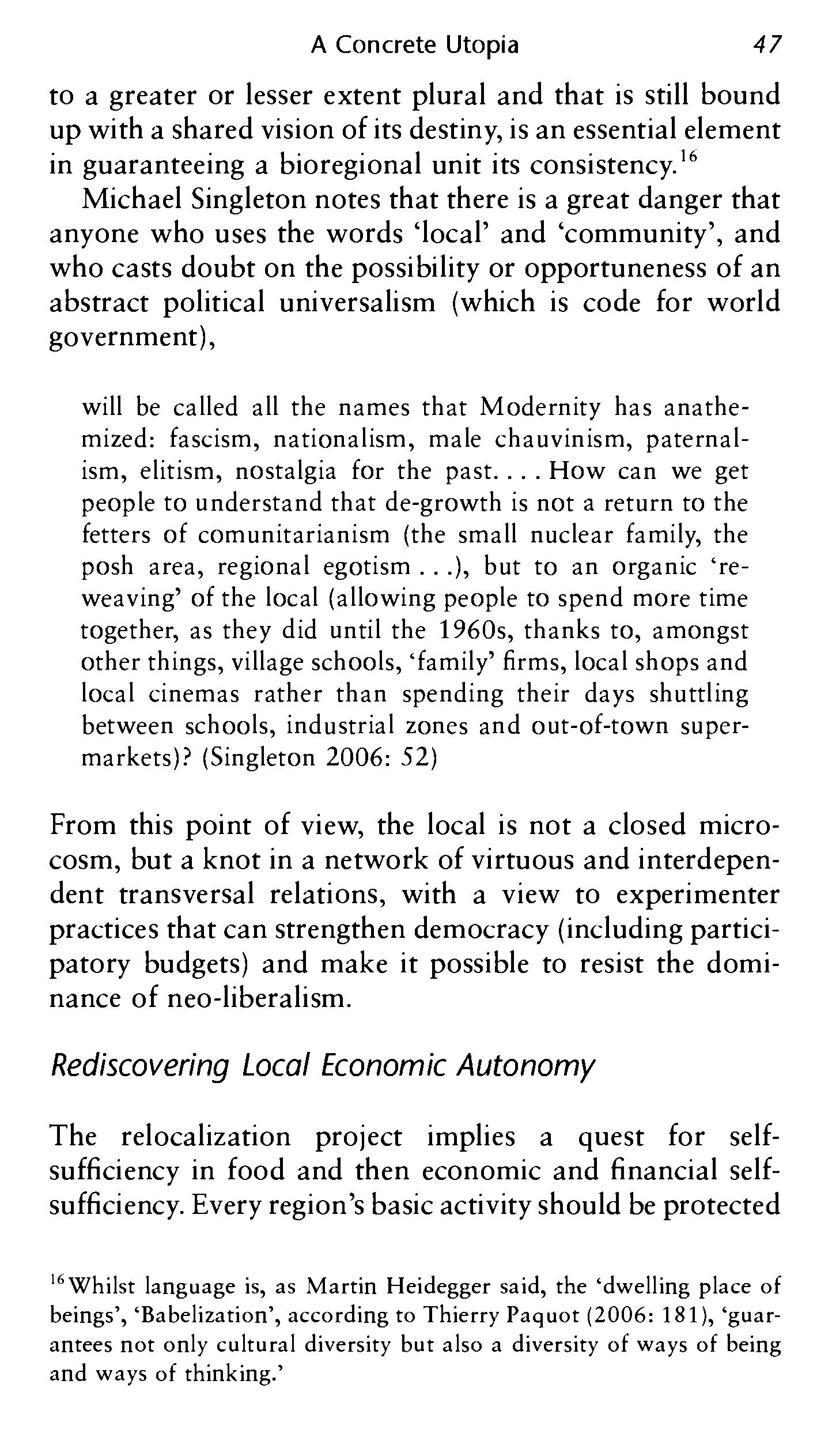
From this point of view, the local is not a closed micro- cosm, but a knot in a network of virtuous and interdepen- dent transversal relations, with a view to experimenter practices that can strengthen democracy (including partici- patory budgets) and make it possible to resist the domi- nance of neo-liberalism.
Rediscovering Local Economic Autonomy
The relocalization project implies a quest for self- sufficiency in food and then economic and financial self- sufficiency. Every region's basic activity should be protected
'6Whilst language is, as Martin Heidegger said, the 'dwelling place of beings', 'Babelization', according to Thierry Paquot (2006: 181), 'guar- antees not only cultural diversity but also a diversity of ways of being and ways of thinking.'
48
A Concrete Utopia and developed, including forms of agriculture and horti- culture, preferably organic, that respect the passage of the seasons.'7 Willem Hoogendijk (2003) looks at the interest- ing example of Holland:
According to calculations by the Dutch Agricultural Economic Institute (LEI) back in 1980, agricultural self- sufficiency was then a viable option for the Netherlands, one of the most densely populated countries in the world. More recently the LEI calculated - to the great surprise of even the researchers - that all 16 million of us could now eat domestically grown organic food (while reducing our meat consumption and eating more seasonable produce).
He then goes on to describe what this new model for agriculture would look like:
Extensive, outdoor agriculture on mixed farms (with live- stock and arable farming combined where possible or at least adjacent, so the manure can be spread back on the farm or on the neighbour's). Extensive horticulture, too, with all the conserving and drying of produce and other work it entails. Then there's our waste, including in the long run our faeces, to return to the land as fertilizer, fodder or soil conditioner. By taking out 'food subscrip- tions' with individual farmers and helping out with the harvest (as is already done throughout the world) we can forge closer bonds between farmers/growers and consum- ers of their produce. And that food will be fresh and healthy, too, subject to lower costs and taxes because of less storage and refrigeration and transport.
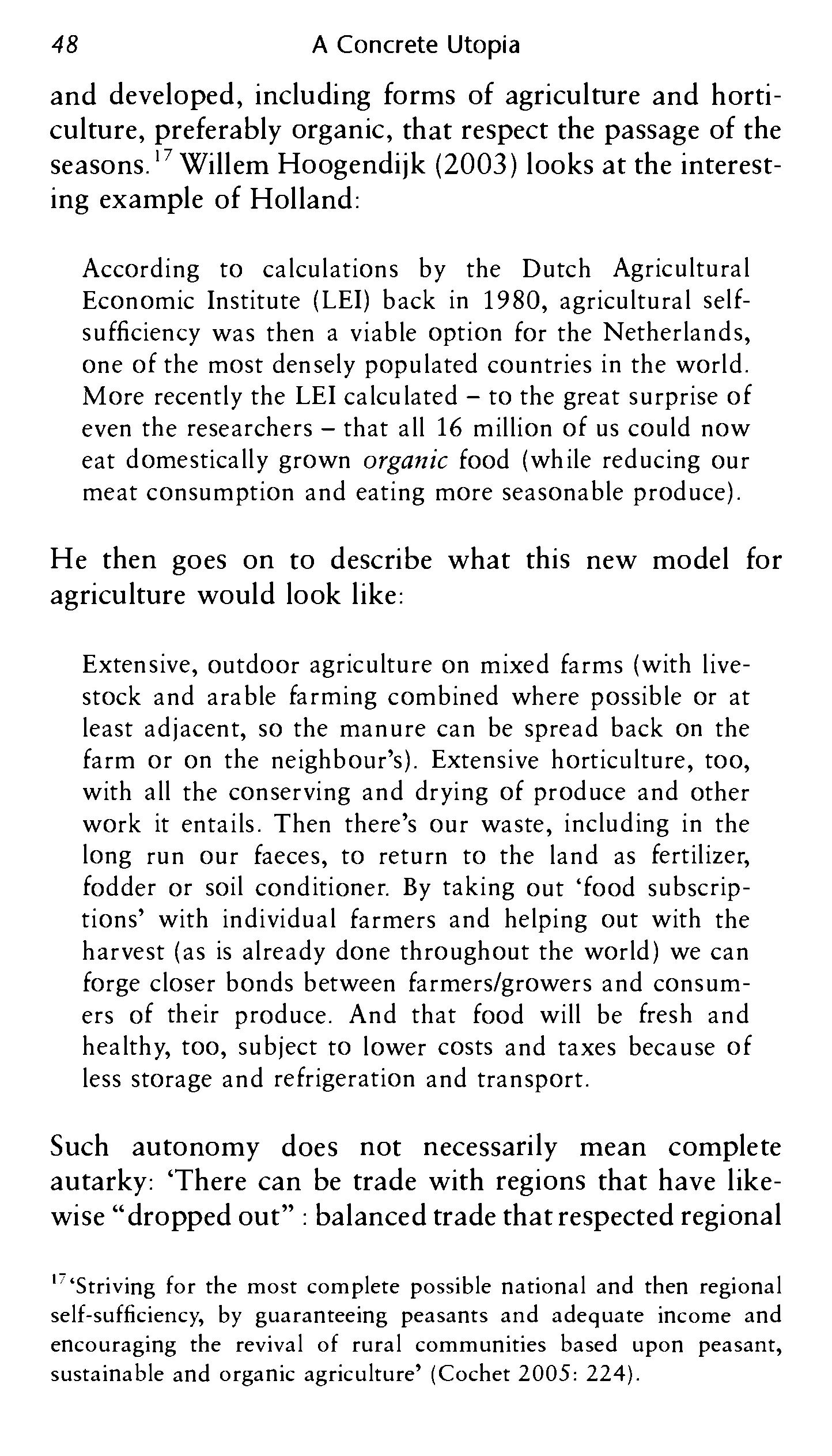
Such autonomy does not necessarily mean complete autarky: 'There can be trade with regions that have like- wise "dropped out" : balanced trade that respected regional
'7'Striving for the most complete possible national and then regional self-sufficiency, by guaranteeing peasants and adequate income and encouraging the revival of rural communities based upon peasant, sustainable and organic agriculture' (Cochet 2005: 224).
independence: i.e. mutual trading of regional surpluses without overstretching people or systems (TVs for dates, butter for olives and so on).'
We can also achieve local autonomy in terms of energy: renewable energies 'are well adapted to decentralized soci- eties in which there are no large concentrations of human beings. But population dispersal is also an advantage: every region in the world has a natural potential to develop one or more form of renewable energy' (Cochet 2005: 140).
Local shops will be encouraged: the creation of one precarious job in the mass market destroys five sustainable jobs in local shops (Jacquiau 2006). According to the French National Institute for Statistics and Economic Studies (INSEE), the appearance of supermarkets (at the end of the 1960s) did away with 17% of bakers in France (17,800), 84% of grocers (73,800) and 43% of hardware dealers (4,300). A significant proportion of local life was destroyed, and much of the social fabric was undone (Ridoux 2006: 11). Given that the big supermarkets' five central purchasing departments now account for 90% of France's retail trade, we've got a lot on our plate.
We must also come up with a real local monetary policy.
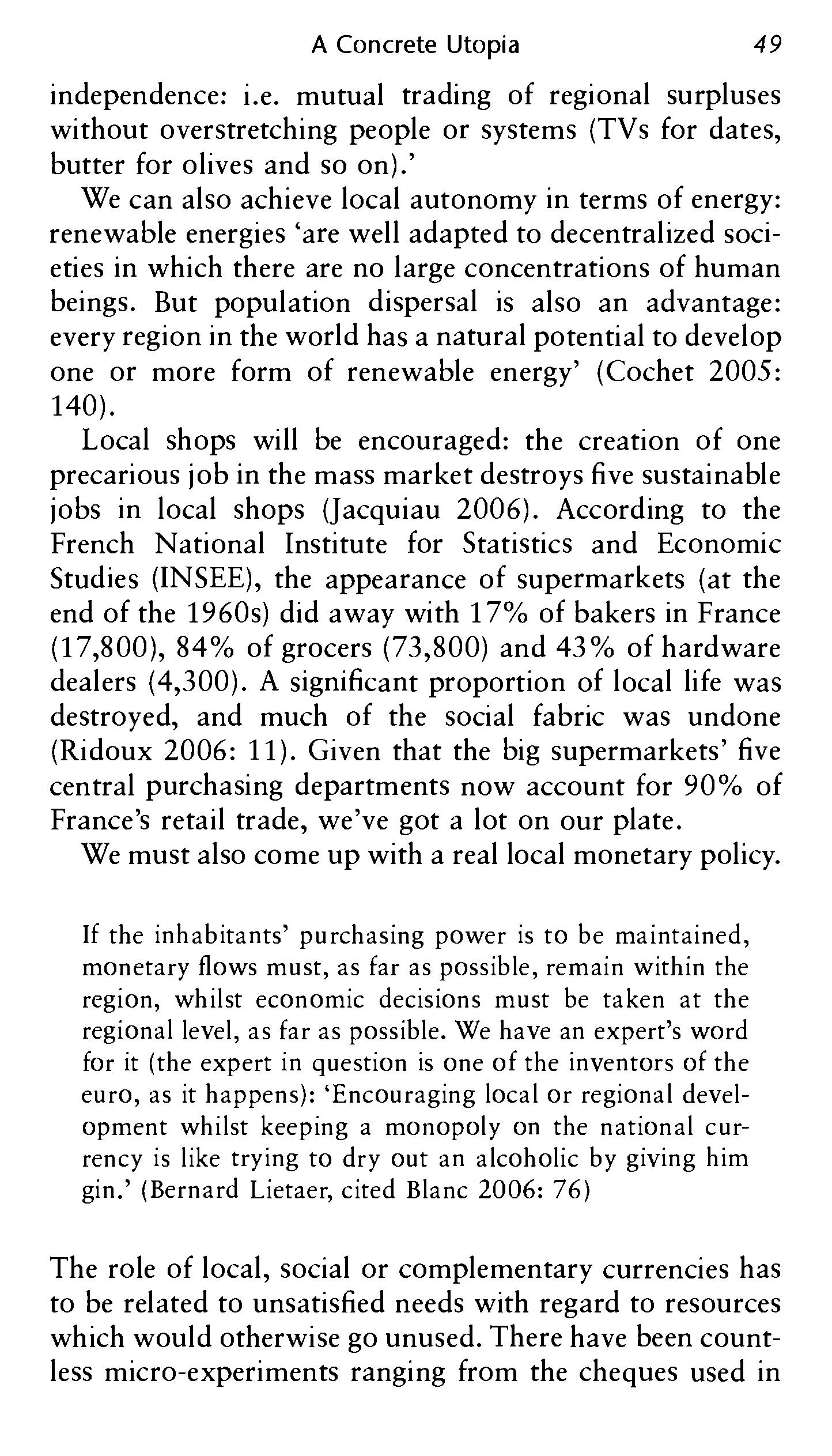
If the inhabitants' purchasing power is to be maintained, monetary flows must, as far as possible, remain within the region, whilst economic decisions must be taken at the regional level, as far as possible. We have an expert's word for it (the expert in question is one of the inventors of the euro, as it happens): 'Encouraging local or regional devel- opment whilst keeping a monopoly on the national cur- rency is like trying to dry out an alcoholic by giving him gin.' (Bernard Lietaer, cited Blanc 2006: 76)
The role of local, social or complementary currencies has to be related to unsatisfied needs with regard to resources which would otherwise go unused. There have been count- less micro-experiments ranging from the cheques used in
SO
A Concrete Utopia local exchange systems, 'free money', Argentina's creditos, to vouchers for specific purposes (transport, meals and fuereai kippu in Japan - 'fraternal relations coupons' for health care for the elderly). And yet no systematic attempt has ever been made to reappropriate the creation and use of local currencies. The bioregion would probably be the ideal scale for such experiments. And no doubt we will have to think about inventing 'bioregional currencies'.
To sum up, regionalization means: less transport, trans- parent production lines, incentivizing sustainable produc- tion and consumption, reducing dependency upon capital flow and multinationals, and greater security in every sense of the word. Regionalizing the economy and embedding it in local societies protects the environment, and the envi- ronment is, in the last analysis, the basis for any economy. Regionalization facilitates a more democratic approach to the economy, reduces unemployment, increases participa- tion (and therefore integration), encourages solidarity, opens up new perspectives for the developing countries and, finally, improves the health of citizens in the rich countries by encouraging sobriety and reducing stress (Hoogendijk 2003).
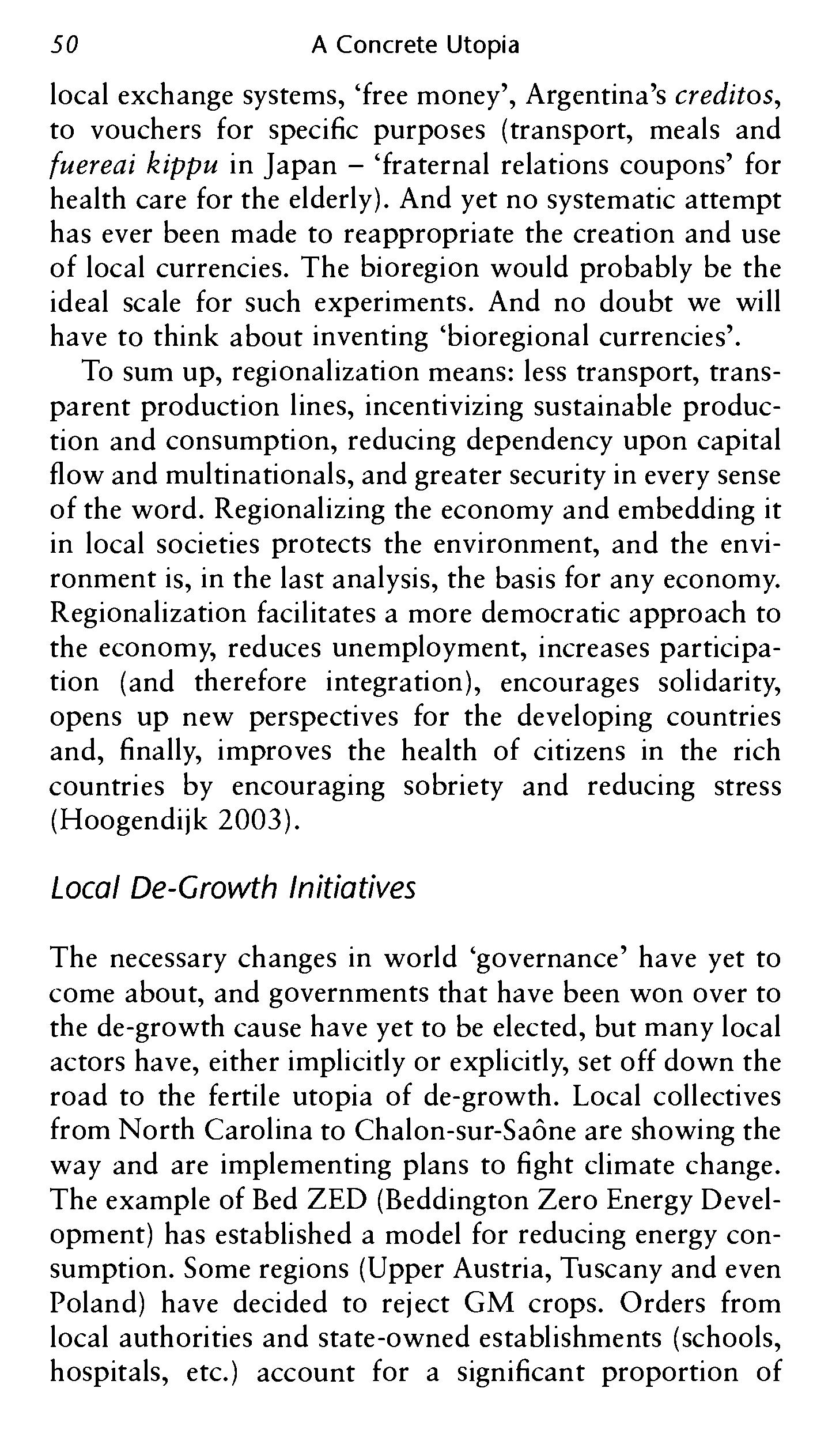
Local De-G rowth Initiatives
The necessary changes in world 'governance' have yet to corne about, and governments that have been won over to the de-growth cause have yet to be elected, but many local actors have, either implicitly or explicitly, set off down the road to the fertile utopia of de-growth. Local collectives from North Carolina to Chalon-sur-Saône are showing the way and are implementing plans to fight climate change. The example of Bed ZED (Beddington Zero Energy Devel- opment) has established a model for reducing energy con- sumption. Some regions (Upper Austria, Tuscany and even Poland) have decided to reject GM crops. Orders from local authorities and state-owned establishments (schools, hospitals, etc.) account for a significant proportion of
A Concrete Utopia Si public spending (12% of GDP in France), and can there- fore be used to popularize the idea of converting the whole economy to ecology. Adapting their terms and conditions would be enough to encourage their beneficiaries to adopt good environmental practices (Canfin 2006: 72). Local authorities can ensure that the establishments under their control rely primarily on local firms and suppliers (Chambéry), insist that public canteens and restaurants use biological agricultural produce (Lorinet, Pamiers), use mechanical or thermal weeding techniques, and not pesti- cides, to maintain public spaces (roadside verges and green spaces), as they have done in Rennes, Grenoble and Muihouse, and use compost instead of chemical fertilizers (Hulot 2006: 170). Several regions in France are encourag- ing the use of public transport: the Rhône-Alpes regional council, for example, points out that since 1997, 400 extra trains have been introduced, 115 stations have been reno- vated and that 60% of the infrastructure has been updated. Passenger numbers have risen from between S to 6% as a result (Ridoux 2006: 86).
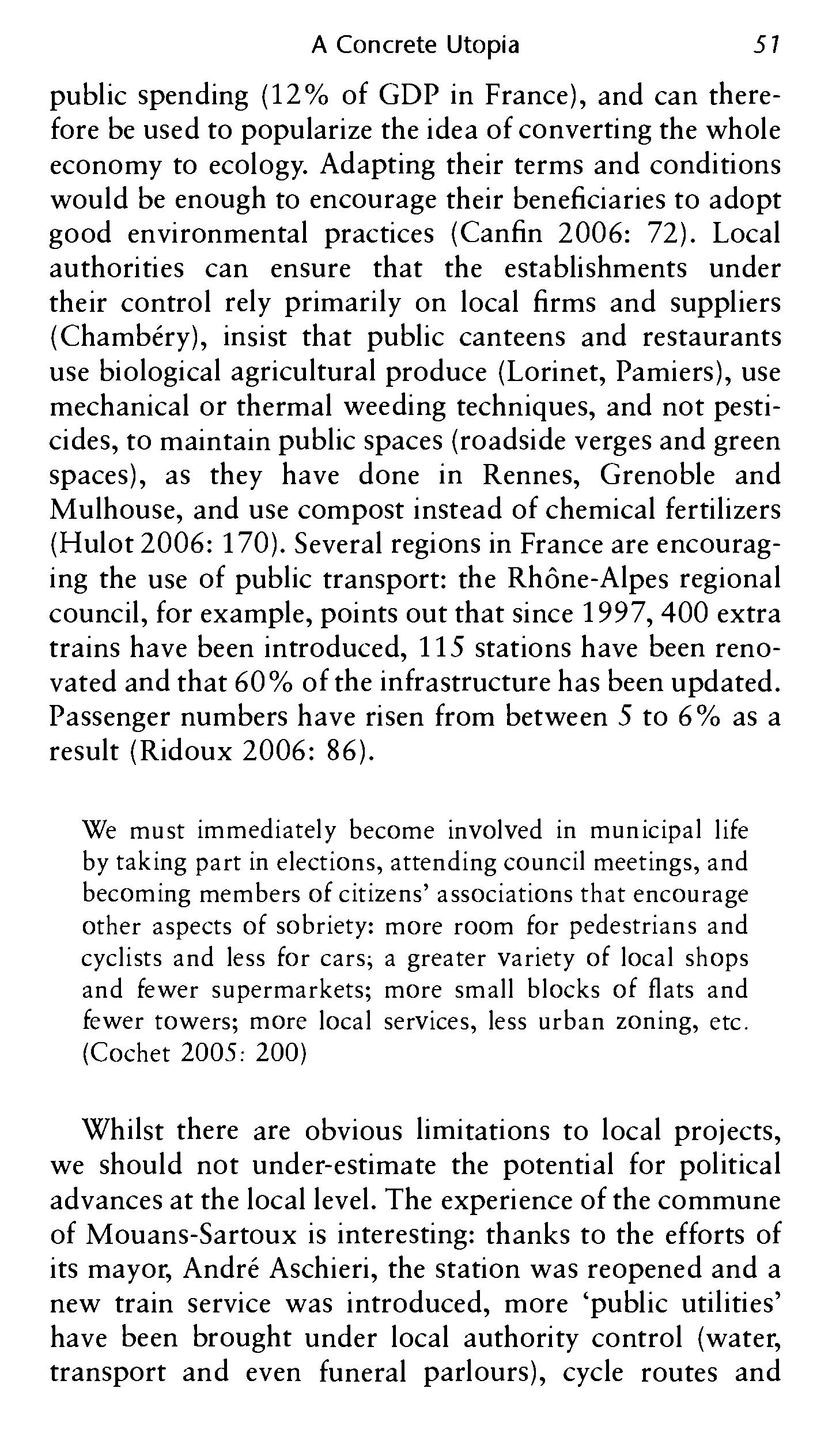
We must immediately become involved in municipal life by taking part in elections, attending council meetings, and becoming members of citizens' associations that encourage other aspects of sobriety: more room for pedestrians and cyclists and less for cars; a greater variety of local shops and fewer supermarkets; more small blocks of flats and fewer towers; more local services, less urban zoning, etc. (Cochet 2005: 200)
Whilst there are obvious limitations to local projects, we should not under-estimate the potential for political advances at the local level. The experience of the commune of Mouans-Sartoux is interesting: thanks to the efforts of its mayor, André Aschieri, the station was reopened and a new train service was introduced, more 'public utilities' have been brought under local authority control (water, transport and even funeral parlours), cycle routes and






